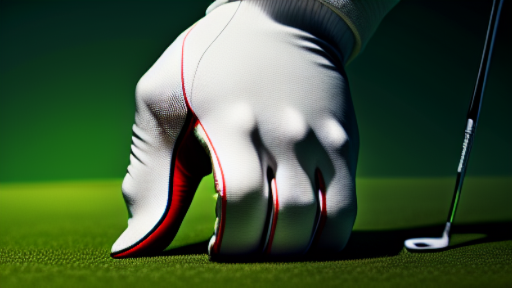@ Midjourney AI Image Prompt: /imagine prompt:”Create an image showcasing a golfer’s hands expertly gripping a golf club, emphasizing grip positioning and posture, against the backdrop of a lush green golf course.” –v 5.2 –ar 16:9
Like a key to a lock, your golf grip can unlock the door to a better game. You’re not alone in the struggle to perfect it. We’re here to guide you with six essential tips.
They’ll help you get a handle on the basics, choose the right gear, and master different grip styles. With our advice, you’ll not only improve your swing but also become part of a community of golfers who’ve unlocked their full potential.
TL;DR – Key Takeaways
- Grip strength is crucial for transferring energy from swing to ball.
- Choosing the right golf glove is important for optimal grip.
- The right golf glove significantly impacts grip and overall performance.
- Proper hand positioning and grip techniques, such as the Vardon grip, are essential for control and power.
Understanding the Basics of Golf Grip
Before you can improve your golf grip skills, it’s crucial for you to grasp the fundamental principles of an effective grip. The importance of grip strength can’t be overstated. It’s the conduit between you and the club, transferring the energy of your swing to the ball.
Think of your grip as the firm handshake between you and your club. Too weak, and you lose control; too strong, and you risk straining your muscles. The grip strength importance lies in its role in maintaining a balanced swing, ensuring the clubface hits the ball squarely. It’s that sweet spot of firm yet relaxed you’re aiming for.
Now, let’s talk about the effects of grip tension. Excessive grip tension can lead to a rigid swing, limiting your swing speed and distance. On the flip side, too little tension can cause the club to slip, leading to inaccurate shots. So, it’s vital to find the ideal grip tension that provides stability without sacrificing flexibility.
Mastering the basics of grip strength and tension is a stepping stone to enhancing your golf grip skills. As you become part of the golfing community, remember, a good grip is the foundation of a great swing.
Choosing the Right Golf Glove
Choosing the right golf glove can greatly enhance your grip skills. It’s not just about picking any glove; you need to consider the material and make sure it fits you perfectly.
Glove Material Selection
When it comes to enhancing your golf grip skills, selecting the right glove material can make a significant difference. Consider factors like glove durability and material breathability.
Here’s a quick guide to help you:
| Glove Material | Durability | Breathability |
|---|---|---|
| Leather | High | Moderate |
| Synthetic | Moderate | High |
| Combo (Leather/Synthetic) | High | High |
| All-Weather | Moderate | Moderate |
| Rain Grip | Low | Low |
Leather gloves are durable but less breathable. Synthetic gloves offer great breathability but compromise on durability. Combo gloves provide both, ideal for regular golfers. All-weather gloves are decent all-rounders, while rain grip gloves, though less durable and breathable, offer superior grip in wet conditions. Choose wisely to suit your needs and enhance your grip game.
Correct Glove Sizing
How do you ensure your golf glove fits correctly and enhances your grip skills?
It’s all about correct sizing. A well-fitted glove should feel like a second skin, snug but not tight. If it’s too large, it can slip, affecting your grip and swing. Conversely, a glove that’s too small can limit your hand movements and decrease glove durability.
Your glove should also match the conditions. For hot weather, opt for gloves with breathable material to wick away sweat. In the rain, choose gloves with weather suitability, providing a firm grip even when wet.
Glove Grip Impact
You’ll find that the right golf glove can significantly impact your grip, influencing numerous aspects of your game. It’s not just about comfort, it’s also about performance. A good glove can aid in grip strength training, providing the necessary friction and grip strength to make those power drives.
A well-fitted glove can also assist with wrist flexibility exercises, allowing for a wider range of motion, and a more fluid swing.
Choosing a glove is like choosing a golf club – it needs to feel right in your hand, providing that perfect balance between comfort and functionality. Experiment with different materials and sizes until you find your perfect fit. Remember, your grip is your connection to the game. Master it, and you’re well on your way to golfing excellence.
Now, let’s dive into the correct hand positioning.
The Correct Hand Positioning
In mastering your golf grip skills, it’s crucial to understand the importance of correct hand positioning. Hand alignment importance can’t be understated – it’s the linchpin of an effective golf swing. The impact of wrist flexion, too, plays a significant role in your overall performance.
Here are some key aspects to consider:
- Hand Alignment: Proper hand alignment is critical for your swing trajectory.
- Your lead hand (left hand for right-handed players) should be on top of the grip, with the thumb pointing down the shaft.
- The trail hand should neatly fit around the other, without any gaps.
- Wrist Flexion: This contributes to clubface control and power.
- The lead wrist should be flat or slightly bowed at the top of your swing.
- The trail wrist should maintain its bend until after impact.
In essence, the correct hand positioning is akin to a well-oiled machine – every component has its place and function. Once you’ve mastered this, you’ll feel a sense of belonging on the golf course as your skills improve. Remember, practice makes perfect, so keep at it.
Vardon Grip: A Closer Look
Now, let’s take a closer look at the Vardon Grip.
You’ll learn about its advantages, how to master it, and common mistakes that can inhibit its effectiveness.
Vardon Grip Advantages
With the Vardon grip, you’ll find it’s easier to control your swings, offering you a significant advantage on the golf course. Rooted in Vardon grip history, this technique, named after Harry Vardon, a golf legend, presents a range of benefits.
To enjoy these perks, remember these grip maintenance tips:
- Consistency: The Vardon grip promotes a more consistent swing. This is because your fingers interlock, offering you a firm, stable hold.
- Power: It allows for more power in your swing. The interlocking fingers provide better leverage, translating into more distance.
As part of our golfing community, integrating the Vardon grip into your game can improve your performance, making you feel more connected and confident on the course.
Mastering the Vardon Grip
To take full advantage of the Vardon grip’s benefits, it’s crucial you master the technique, giving each of your swings a professional touch.
The Vardon grip history dates back to the 19th century, when Harry Vardon, a golf legend, introduced it. A keen understanding of its history can deepen your appreciation for this effective grip.
Famous players using the Vardon grip, like Tiger Woods, swear by its ability to provide control and power. To emulate their success, your left fingers need to rest snugly on your right ones, with your right pinky finger overlapping the gap between your left index and middle finger.
Practice this grip, feel its unique comfort, join the ranks of the pros, and enhance your golfing prowess.
Common Vardon Grip Mistakes
While you’re working on mastering the Vardon grip, it’s important to be aware of common mistakes that can hinder your progress. Rooted in Vardon grip history, these errors can lead to grip-related injuries.
- Not placing the pinkie properly:
- Overlapping too lightly: It should nestle into the gap between the index and middle fingers.
- Overlapping too deeply: This can cause unnecessary strain.
- Improper thumb position:
- Too far around the grip: It can cause loss of control.
- Not enough pressure: A loose thumb grip can lead to a weak swing.
Avoid these mistakes to become part of the successful Vardon grip community. Understanding these pitfalls is just the beginning. Now, let’s take a closer look at the interlocking versus overlapping grip debate.
Interlocking Versus Overlapping Grip
In your quest to improve your golf game, understanding the difference between an interlocking and overlapping grip is a crucial step. Both grips have unique advantages and implications for your grip strength and grip longevity.
The interlocking grip involves intertwining the index finger of your top hand and the little finger of your bottom hand. It provides a secure, unified grip, which can enhance your grip strength. However, it may take time to get comfortable with it.
On the other hand, the overlapping grip, also known as the Vardon grip, is where you place the little finger of your bottom hand between the index and middle finger of your top hand. This grip can provide you with more feel and control, enhancing grip longevity.
Here’s a table for quick reference:
| Grip Type | Strength | Longevity |
|---|---|---|
| Interlocking | High | Moderate |
| Overlapping (Vardon) | Moderate | High |
The Role of Thumb and Forefinger
You’ve got to understand the critical role your thumb and forefinger play in establishing a solid golf grip. Thumb positioning and forefinger strength are key to a strong hold and a controlled swing.
Consider these points:
- Thumb Positioning
- The correct position of your thumb on the grip can make or break your swing. It should rest on the side of the grip, pointing down towards the club head. This position gives you leverage and control.
- Not only where, but how you place your thumb matters. A relaxed yet firm placement can enhance your swing’s power and accuracy.
- Forefinger Strength
- Your forefinger provides the necessary pressure to maintain a solid grip. However, too much pressure can negatively affect your swing. It’s a delicate balance.
- Training your forefinger strength can greatly improve your grip. Simple exercises, like squeezing a stress ball, can enhance your hold on the club.
Getting your thumb and forefinger in sync is an art that takes time to master, but the rewards are worth it. Remember, it’s not about gripping harder, but smarter.
Now let’s transition into our next section – mastering grip pressure.
Mastering Grip Pressure
Mastering grip pressure is a crucial aspect of your golf game that you can’t afford to overlook. It’s the bridge between you and your club, a vital connection that profoundly influences your swing. You’re not just holding the club; you’re communicating with it, transmitting your intentions through subtle pressure variations.
Grip pressure isn’t about squeezing the life out of your club. On the contrary, it’s about a firm but relaxed grip that allows flexibility and adaptability. The secret lies in grip endurance, the ability to maintain optimal pressure from start to finish. It’s not just about the initial grip but also about enduring the entire swing without losing pressure control.
The key is to find a balance. Too much pressure and you’ll stiffen up, reducing your swing’s fluidity and power. Too little, and you won’t have adequate control over the club. Practice different pressure variations until you find the sweet spot that works for you.
Adjusting Grip for Different Shots
Adjusting your grip for different shots is an essential skill you’ll need to master, allowing you to adapt your game to various situations on the golf course. You’ll need to consider factors like weather conditions and the desired swing speed.
You may need to make grip alterations for weather conditions. For example:
- In wet conditions, a tighter grip might provide better control.
- But remember, don’t tense up. You want to maintain a firm but relaxed grip.
- In dry, hot conditions, you may be able to loosen your grip slightly, allowing for a smoother swing.
The impact of grip on swing speed is also significant. Here are some tips:
- A lighter grip can often lead to an increase in swing speed.
- Yet, too light and you risk losing control of the club.
- A firmer grip can offer more control but may reduce your swing speed.
- So, find the balance that works best for you.
Consistent Practice for Grip Improvement
To improve your golf grip skills, it’s crucial that you dedicate consistent time to practicing and refining your techniques. Don’t underestimate the power of regular grip strength training. This isn’t just about getting stronger; it’s about fine-tuning the muscles in your hands and forearms to respond effectively and consistently to your mental commands.
Incorporate specific exercises into your routine, like squeezing a stress ball or using a hand gripper. These tools can help enhance your grip strength, offering more stability and control during your swing.
Now, let’s talk about weather impact. Changing weather conditions can affect your grip. On hot, humid days, your palms might get sweaty, making the club slip. On cold days, your hands might stiffen, affecting your grip strength. Practice in varying weather conditions to become adaptable.
Remember, what you’re after isn’t just improvement, but consistency. That’s what separates the casual golfers from the pros. So, keep practicing, stay patient, and you’ll find your grip becoming more reliable, your swings more powerful, and your overall game improving.
You’re part of a community that strives for excellence, and every bit of effort you put in brings you closer to your goals.
Grip it and Rip it!
So, are you ready to up your golf game? Remember, it all starts with your grip.
Choose the right glove, position your hands correctly, and understand the Vardon, interlocking, and overlapping grips. Don’t underestimate the power of your thumb and forefinger.
Learn how to adjust your grip for different shots, and most importantly, practice consistently.
With these tips, you’re well on your way to mastering the art of the golf grip.
The green is awaiting your prowess.





